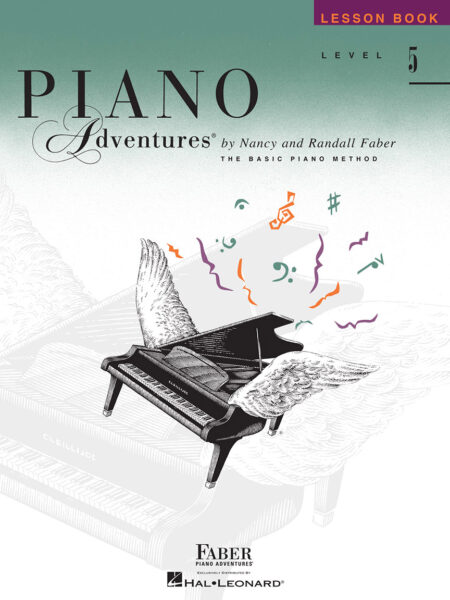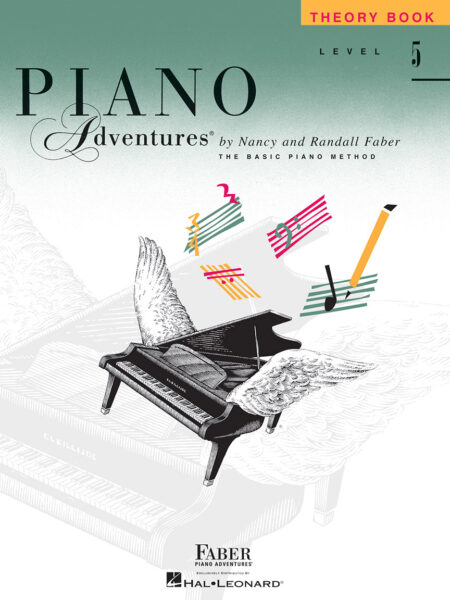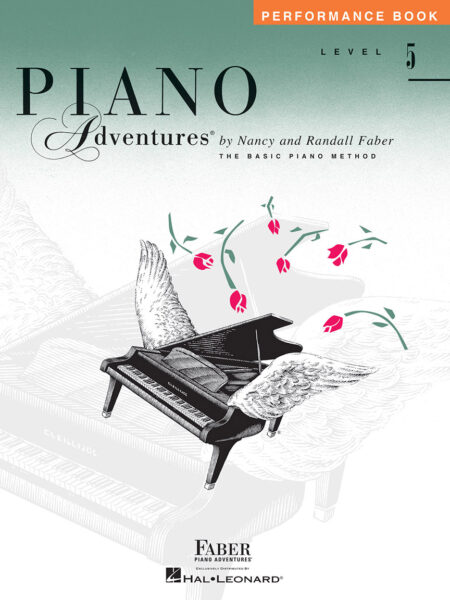
20Questions and Answers for Level 5
About the Level 5 Books
- The Level 5 Lesson Book starts with a Level 4 Review, “Get Ready for Take-off!” Is this important to do?
- Should I use all four core Level 5 Books: Lesson, Theory, Technique & Artistry, and Performance?
- How do I fit all four Level 5 books into a lesson?
- What is the best way to use “Coral Reef Etude?” (p. 6)
- Should students eventually learn “Grand Cadence” in all 12 keys?
- “Tumbleweed Blues” is in 12/8 time. Should I introduce the word “compound meter?” (p. 12)
- How can I reinforce perfect intervals and major/minor intervals? Can “Interval Travel” be used as a warm-up? (p. 18)
About the Level 5 Student
- Are there any student-student duets at Level 5?
- Should students memorize the flat pattern on page 32? What are some tricks to remember the flat keys?
- How important is it to have students memorize Level 5 pieces?
- Where can I find lead sheets for the Level 5 student?
- Should a student use a Literature Book in Level 5? Which book should be used?
- What pieces could a Level 5 student play for extra fun?
- Do Level 5 students compose?
- Are there other ways students can practice the circle of 5ths? (pp. 22-23)
- Do you teach the flat scales one at a time with the piece given? Do you ever teach students flat scales as a group? (p. 33)
- Could a Level 5 student begin teaching piano as a teacher’s assistant?
- Can I teach Level 5 students in an online lesson? What are some teaching tips?
About the Level 5 Adventure Learning Videos
About the Level 5 Audio Files
1.The Level 5 Lesson Book starts with a Level 4 Review, “Get Ready for Take-off!” Is this important to do?
The Level 4 Review that begins Level 4 Review is a handy teacher assessment tool. Use it for students graduating to Level 5 as well as transfer students. The Level 4 Review helps the teacher assess what is understood and what needs more support.
Rhythm review includes time signatures (4/4, 3/4, 3/8, 6/8), triplet rhythms, and 16th notes. Reading review covers intervals (2nd, 3rd, 4th, 5th, 6th, 7th, and octave). Theory review includes writing sharps or flats to complete major and minor scales, writing the sharp pattern, root position V7 chords, and identifying various symbols and terms.
Areas in which the student lacks confidence allow the teacher to “review and renew” understanding. Explore board work and give cheerful explanations of concepts, along with investigative questions, to review concepts together. Consider using the Level 4 Sightreading Book for students who need a reading boost. This will help them develop faster recognition of chords, intervals, and rhythm patterns for success in Level 5.
Level 5 Lesson Book
Jazz Reflection (Level 4 Review, pp. 4-5)
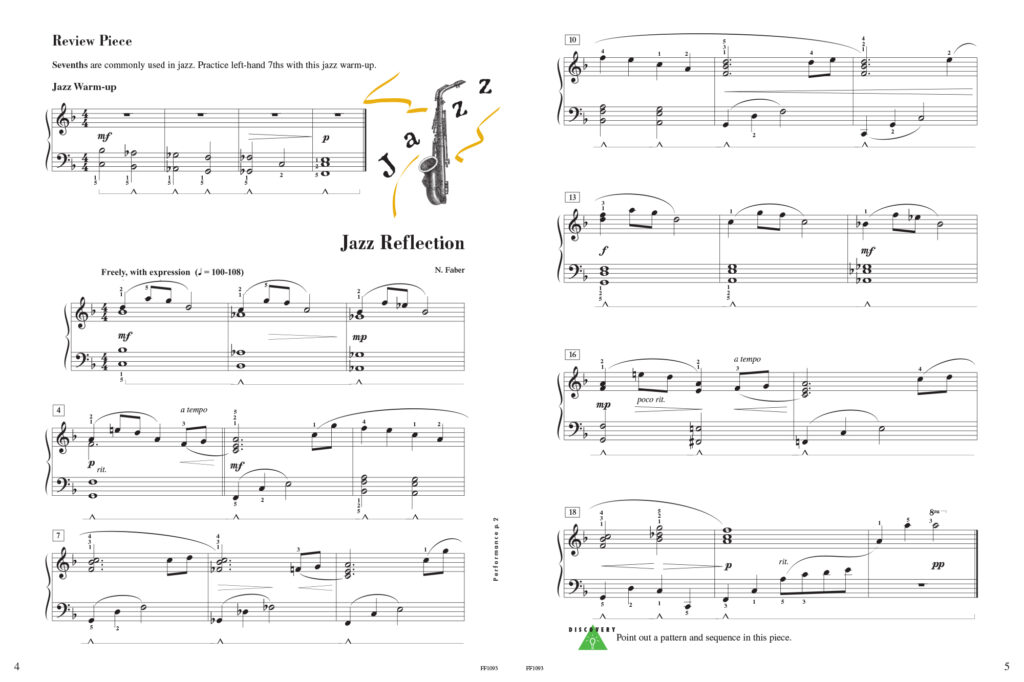
2.Should I use all four core Level 5 Books: Lesson, Theory, Technique & Artistry, and Performance?
The Level 5 Books (Lesson, Theory, Performance) form a set for wholistic learning: repertoire, ear-training, improvisation, composing, and sightreading.
For important work with advancing technique, it’s recommended that teachers and students use the Hanon-Faber, The New Virtuoso Pianist. This book uses select Hanon exercises from Hanon’s Part 1 and 2 and includes Randall Faber’s “transformative warm-ups for gesture and virtuosity.” Teachers will find that the Technique Secrets learned in earlier levels will work well for the Hanon exercises. These include wrist circles, rotation, and alignment, among others.
3.How do I fit all four Level 5 books into a lesson?
The three most important books at Level 5 are the Lesson Book, the Theory Book, and the Hanon-Faber, The New Virtuoso Pianist. A 45-minute lesson or one-hour lesson is highly recommended for the Level 5 student, offering a distinct time advantage for covering essential material.
If time is short, consider demonstrating the Performance Book piece while the student watches the music. Give a few pointers, then assign to learn at home as your own “adventure piece.” This gives the teacher an opportunity to see what is easy and what is challenging at the next lesson.
For the Theory Book, the teacher might do the first example on a page with the student, then assign to complete at home. With careful lesson planning and efficient use of lesson time, the four books can be implemented, even if one book is not covered in some lessons.
4.What is the best way to use “Coral Reef Etude?” (p. 6)
“Coral Reef Etude” offers an arpeggiated, pedaled inversion study. Students link the terminology of tonic, sub-dominant, and dominant with I, IV, and V. The Discovery Question prompts students to transpose to G.
A terrific use of “Coral Reef Etude” is to play it chromatically up the keys, C to C. Play slowly at first. Perhaps the first week, play C up to F (C, D![]() , D, E
, D, E![]() , E, F). The second week add F up to C (F, F
, E, F). The second week add F up to C (F, F![]() , G, A
, G, A![]() , A, B
, A, B![]() , B, C). The following week work on building speed.
, B, C). The following week work on building speed.
This has so much value for the student. Now, in addition to thinking intervals they are thinking chord function as well. Students love the fun of seeing their abilities soar. Within a month of steady practice, they can be enjoying the sound of rippling chord inversions across the keyboard.
Level 5 Lesson Book
Coral Reef Etude (p. 6)

5.Should students eventually learn “Grand Cadence” in all 12 keys?
Yes, this is an excellent idea!
The “Grand Cadence” (bottom of p. 7) is presented with blocked chords in C major. Students transpose to G, D, A, E, and F. The Creative activity that follows directs students to create their own broken chord exercise using the Grand Cadence.
Anytime we can take a chord progression and have the student play it in all 12 keys, musicianship grows. This I-IV-I-V-I progression picks up on prior chord knowledge, now placing it in the context of new language, the “cadence.” Throughout Level 5 students are coached to notice cadence points for phrases, sections, or the ends of pieces.
To work up to all 12 keys, consider assigning C, D, E, F, G, A, B first, until this is comfortable. Then play the Grand Cadence up the keys chromatically:
C—D![]() —D—E
—D—E![]() —E—F—F
—E—F—F![]() —G—A
—G—A![]() —A—B
—A—B![]() —B—C
—B—C
Level 5 Lesson Book
Grand Cadence (p. 7)

6.“Tumbleweed Blues” is in 12/8 time. Should I introduce the word “compound meter?” (p. 12)
In Level 5 the time signature for 12/8 is prepared with 6/8 time. This is similar to Level 3A where 6/8 time is prepared with 3/8 time.
“Blue Etude” in 6/8 time serves as the warm-up for “Tumbleweed Blues” in 12/8 time. An important discussion to have with students is recognizing the main beats or pulses in 12/8 time while also understanding the subdivision of each beat:
12/8 time: 1 + a 2 + a 3 + a 4 + a
Just as the word “cadence” becomes part of the Level 5 student’s lexicon, so does the term “compound meter.” When the top number of a time signature can be divided by 3, the beats also can be divided by 3’s, each group becoming a main pulse. 6/8 is a compound meter with 2 pulses per measure. 12/8 is a compound meter with 4 pulses per measure.
Further work with 12/8 is reinforced with the Theory Book and Performance Book.
Level 5 Theory Book
4groups of 3 = 12! (p. 5)
 v
v
Level 5 Lesson Book
Tumbleweed Blues (p. 12)

Level 5 Performance Book
Poetic Theme and Variations (pp. 7-9)


7.How can I reinforce perfect intervals and major/minor intervals? Can “Interval Travel” be used as a warm-up? (p. 18)
Although students have played 4ths, 5ths, and octaves for some time, the Level 5 now names them as “perfect intervals” within the new context of learning major/minor 2nds, 3rds, 6ths, and 7ths.
The Lesson Book, p. 18 (shown below) begins with Ear-Training to hear perf
The exercise “Interval Travel” (in the purple box) presents all the intervals (perfect, major, and minor) for students to locate on the keys. This takes practice, especially major/minor 3rds, 6ths, and 7ths. Many helpful hints for recognition are given in the Theory Book, p. 16 (See below.)
The Theory Book (pp. 8-16), includes 9 pages of in-depth interval work that covers visual recognition, ear-training, composing, and sightreading. Perhaps the best quick review is for teachers to frequently make up their own “Interval Travel” (Lesson Book. p. 18) at lessons. Think of it as a 30-second theory warm-up for a new piece. Students think in the “language of that key.”
Level 5 Lesson Book
Naming Intervals (p. 18)

Level 5 Theory Book
Perfect Intervals (p. 8)

Brain Teasers (p. 10)

Composing (p. 11)

Major and Minor 7ths (p. 14)

Ear-Training (p. 16)

About the Level 5 Student
8.Are there any student-student duets at Level 5?
Level 5 does not feature any student-student duets in the core books.
However, there are several duets in the Developing Artist Literature Books that could be of interest for Level 5 students. (See below.)
Preparatory Piano Literature
Melody (Beyer, pp. 14-15)

Piano Literature Book 1
Waltz for Four Hands (Wohlfahrt, pp. 24-25)

Piano Literature Book 2
Polka (Hummel, pp. 24-25)

Piano Literature Book 3
Rondo for Four Hands (Diabelli, pp. 40-41)

Piano Literature Book 4
Concerto in C (solo with 2nd piano part, by Haydn, pp. 57-58)
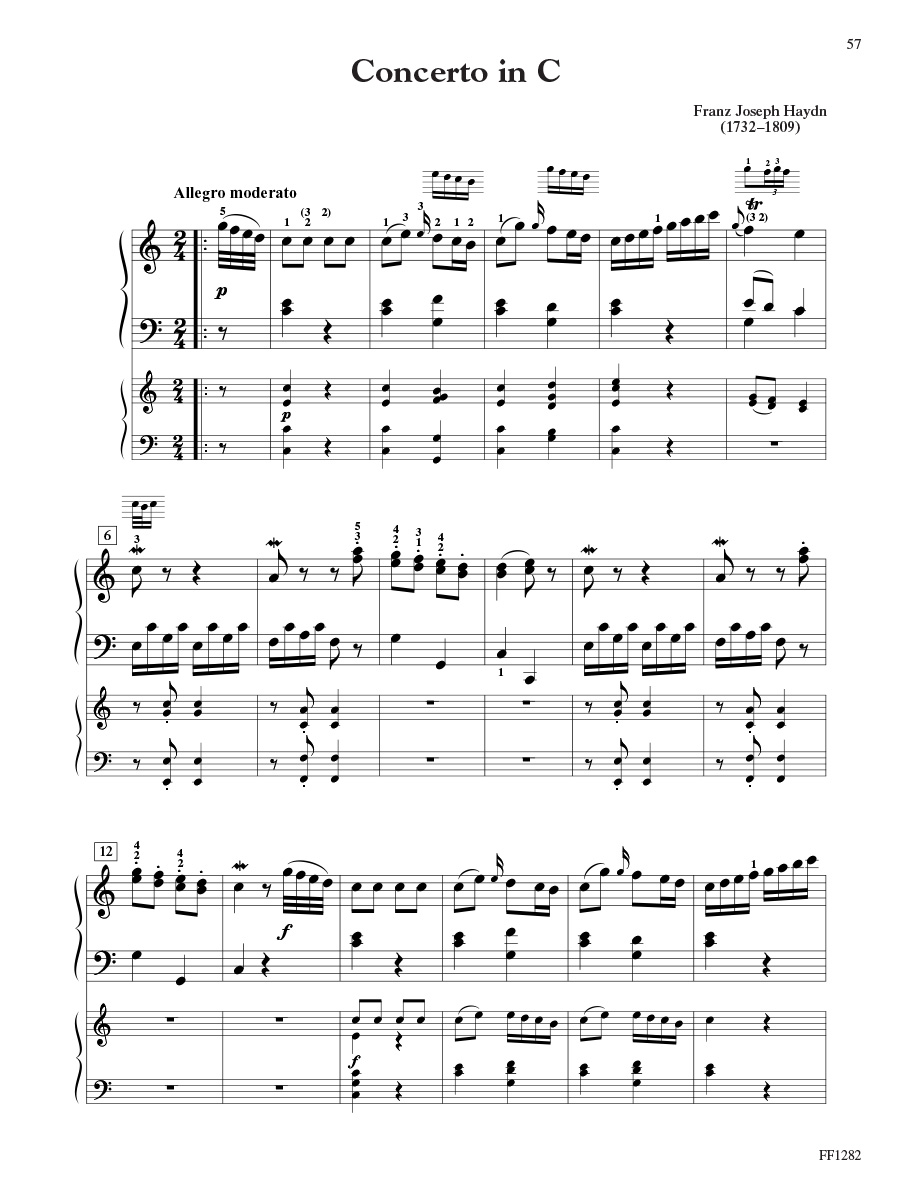
Lastly, Level 5 students can enjoy playing a Teacher Duet from the PreTime, PlayTime, or ShowTime Books with a sibling or younger student in that level.
9.Should students memorize the flat pattern on page 32? What are some tricks to remember the flat keys?
Yes, students should memorize the flat pattern and write it regularly during Level 5 to build their theory “toolkit.” Review the sharp pattern as well!
To write the flat pattern in the correct order (Lesson Book, p. 32) try this memory aid. Think the word:
“B— E— A— D” and then these 3 letters “G— C— F.”
Along with writing the flat pattern in both clefs, practice writing flat key signatures on staff paper. A good strategy is to begin writing the flat pattern (B![]() — E
— E![]() — A
— A![]() — D
— D![]() — G
— G![]() — C
— C![]() — F
— F![]() ) and write one flat past the name of the key. For instance, to write the key of A-flat, write the flat pattern from the beginning and write up to D-flat, one flat past the Ab.
) and write one flat past the name of the key. For instance, to write the key of A-flat, write the flat pattern from the beginning and write up to D-flat, one flat past the Ab.
Sample flat pattern instructional pages.
Level 5 Lesson Book
Flat Key Signatures (p. 32)

Level 5 Theory Book
Famous Marches (p. 24)

In No Time Flat (p. 25)

10.How important is it to have students memorize Level 5 pieces?
This is an interesting question. Ideally, memorization begins very early in piano study, even at the Primer Level. A student memorizes a piece every week. The ease of memorizing these very short pieces brings skill and confidence in memorizing.
A student who has not memorized prior to this point will probably find it more challenging to memorize Level 5 and other piano literature pieces.
Basic thoughts about memorizing:
- All memorization is good for a student’s musical mind.
- Every piece does not need to be memorized, of course. However, a student can be expected to play the opening section by memory. Or the opening theme. Or even just the Coda!
- Always build memory capacity even through small assignments.
- Understanding the musical form of a piece is always an aid to memory. The ability to “Start at the B section with your RH on the dominant,” for instance, gives remarkable security.
- Memorizing the LH alone for a bass line allows the student to scrutinize the intervals. This will be very helpful in playing hands together by memory.
- Consider having what might be called memory “pegs” in each piece. These are spots where a student can begin “cold,” without hesitation. A peg can be the beginning of a section, a phrase, or really anywhere the student chooses. In a performance, should it become necessary, the student can simply jump to a “peg” and be on their way.
- Once a student has memorized a piece, celebrate by playing the piece(s) often at lessons.
Most students enjoy having the teacher sit on a couch or chair, away from the piano, creating a performance space. Listen to the memorized piece encouraging the student to command the space!
Consider also ending a lesson in this way. The student might play a well-prepared piece from Level 5 using the music. Then close with a memorized piece for a special achievement.
11.Where can I find lead sheets for the Level 5 student?
Lead sheets are one of the best ways ever to actively apply the theory of major and minor chords, learn to create with different accompaniment patterns, and be able to play scores of songs.
Level 5 lead sheets for download are coming soon.
12.Should a student use a Literature Book in Level 5? Which book should be used?
At Level 5 a student could start Piano Literature Book 3 or Piano Literature Book 4. The teacher can determine the best choice depending on the student’s interest and ability.
Piano Literature and Piano Sonatina Books give teachers the opportunity for “musical chats” with the student—to compare form, keys, harmony, accompaniment patterns, and phrasing.
13.What pieces could a Level 5 student play for extra fun?
For extra Level 5 fun, BigTime Piano Books span Level 4 and Level 5 and offer a variety of styles with many familiar songs.
Level 5 students can start any BigTime Book that captures their interest. BigTime books are also useful for traveling through different musical styles, accompaniment patterns, keys, rhythm patterns—so necessary for fluency and flair at the keyboard.
Here are a few favorites.
BigTime Disney Book
Aladdin Medley (pp. 30-33)


BigTime Music from China Book
Shepherd’s Song (pp. 24-27)


BigTime Jazz & Blues Book
All the Things You Are (pp. 36-37)

AdvanceTime Christmas Book
A Celebration of Carols, Christmas Medley (pp. 34-37)


14.Do Level 5 students compose?
There are many opportunities to compose at Level 5. These activities are integrated throughout the level and bring support to new concepts presented.
Level 5 Theory Book
New River Etude in E Major (p. 6)

Composing with 4ths and 5ths (p. 9)

Composing with the Circle of Fifths (pp. 18-19)

15.Are there other ways students can practice the circle of 5ths? (pp. 22-23)
There are many other ways to practice the Circle of 5ths. The Creative suggestions at the bottom of p. 23 encourage students to explore this.
Some possibilities might include:
- Play major I chords around the Circle of 5ths, hands alone, then hands together. Use pedal.
- Play minor I chords around the Circle of 5ths, hands alone, then hands together. Use pedal.
- Play a chord progression around the Circle of 5ths, hands alone or together.
Ex. Key of C: I – IV – I – V7 – I, then
Key of G: I – IV – I – V7 – I, then
Key of D: I – IV – I – V7 – I, and so forth through the Circle.
Play cross-hand arpeggios around the Circle of 5ths. Use pedal.
Level 5 Lesson Book
The Circle of 5ths, Around the World (pp. 22-23)

16.Do you teach the flat scales one at a time with the piece given? Do you ever teach students flat scales as a group? (p. 33)
Teaching the flat scales, F, B![]() , and E
, and E![]() (p. 33) in one lesson has an advantage for those students willing to take the challenge. The scale patterns can be readily seen and immediately applied.
(p. 33) in one lesson has an advantage for those students willing to take the challenge. The scale patterns can be readily seen and immediately applied.
- The RH thumb always falls on F and C for these flat scales: F, B
 , E
, E , A
, A , and D
, and D . Though Level 5 presents only F, B
. Though Level 5 presents only F, B , and E
, and E scales, students can readily learn these other flat scales using the same fingering rules.
scales, students can readily learn these other flat scales using the same fingering rules. - For the LH flat scales, the finger pattern 3 2 1—4 3 2 1 is easy to remember for B
 , and E
, and E . The A
. The A and D
and D scales follow the same rules and can also easily be learned.
scales follow the same rules and can also easily be learned.
17.Could a Level 5 student begin teaching piano as a teacher’s assistant?
This is an interesting concept— a Level 5 student can be a practice partner for a younger student! Particularly with Zoom lessons available in most households, a younger student is usually thrilled to have an older student “mentor” them— hear their pieces, joke around a bit, and receive encouragement with a Zoom “playdate.”
Even if only for 15 minutes once or twice a week, this gives the Level 5 student a chance to “give back,” builds on the idea of service, and usually benefits the Level 5 student in unexpected ways, not to mention the younger student. The long-term result may be a future piano teacher in the making!
18.Can I teach Level 5 students in an online lesson? What are some teaching tips?
Yes, it is completely possible to teach Level 5 books in an online lesson, such as Zoom.
The best way to do this is through subscribing to the Teacher Atlas and using its screen-sharing capability. All books in the Faber Library are available for viewing and screen sharing, including the Level 5 method books, Hanon-Faber Book, BigTime Piano Books, Literature Books, and Scale Books.
Here are some ideas for teaching the Level 5 Lesson Book in an online lesson.
NOTE: Have the student become very familiar with the music before playing. Accomplish this through questions that require active responses from the student. Keep the discussion light, upbeat, and “congratulatory” as the student answers.
See Level 4 Questions and Answers, Question 18 for examples.
About the Level 5 Adventure Learning Videos
19.What are the Adventure Learning Videos?
These videos feature close-ups of the hands with simple text that taps the student’s “musical mind” with theory analysis and technique tips.
Adventure Learning Videos for Level 5 are not yet available but are planned to be modeled after the Primer Adventure Learning Videos.
About the Level 5 Audio Files
20.What are the audio files and how should I use them?
Orchestrated accompaniments are available in the Audio Cloud and Piano Adventures Player app. Have fun exploring with your students!
Preview a track a week before teaching it at the lesson. As you listen together, discuss the sound. Is the tempo fast or slow? What is the mood of the piece? Can you name one of the instruments that is playing?
Playing with a background accompaniment demands correct rhythm, and can be more fun than using a metronome. Students learn to feel the meter and understand the need to “keep going.” Demonstrate with the practice tempo track and point to beat 1 of each measure in time with the beat.
The musical vignettes in this series introduce the student to a variety of musical sounds and ensembles, such as the marching band, chamber orchestra, jazz ensemble, rock band, and more.



